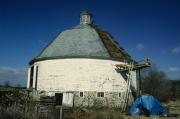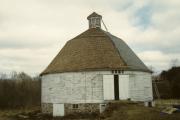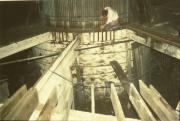Property Record
N SIDE OF RD, .5 M E OF STATE HIGHWAY 146
Architecture and History Inventory
| Historic Name: | Nashold 20-sided Barn |
|---|---|
| Other Name: | Albert Petrick Barn |
| Contributing: | |
| Reference Number: | 3405 |
| Location (Address): | N SIDE OF RD, .5 M E OF STATE HIGHWAY 146 |
|---|---|
| County: | Columbia |
| City: | |
| Township/Village: | Fountain Prairie |
| Unincorporated Community: | |
| Town: | 11 |
| Range: | 12 |
| Direction: | E |
| Section: | 8 |
| Quarter Section: | SE |
| Quarter/Quarter Section: | SE |
| Year Built: | 1911 |
|---|---|
| Additions: | |
| Survey Date: | 1974 |
| Historic Use: | centric barn |
| Architectural Style: | Other Vernacular |
| Structural System: | |
| Wall Material: | Clapboard |
| Architect: | |
| Other Buildings On Site: | |
| Demolished?: | No |
| Demolished Date: |
| National/State Register Listing Name: | Nashold 20-sided Barn |
|---|---|
| National Register Listing Date: | 2/11/1988 |
| State Register Listing Date: | 1/1/1989 |
| National Register Multiple Property Name: |
| Additional Information: | A 'site file' exists for this property. It contains additional information such as correspondence, newspaper clippings, or historical information. It is a public record and may be viewed in person at the Wisconsin Historical Society, Division of Historic Preservation-Public History. Nestled in gently rolling terrain, this is perhaps the state’s best example of a polygonal barn. The twenty-sided structure rests on a raised-basement of fieldstone, where the cattle and horses were stanchioned in a circle around a central silo. Above that level rises a clapboard-sheathed hayloft, entered via an earthen ramp, which allowed the farmer to drive his wagon directly into the building. Inside the hayloft is a large open space, broken only by the center silo. A twenty-sided self-supporting roof shelters the entire structure, and a ten-sided cupola provides both ventilation and a measure of illumination. From about 1890 until 1914, Wisconsin’s farmers made the transition from wheat farming to dairying, and the countryside witnessed a flurry of interest in polygonal and round barns. The state’s first centric barns were usually octagonal, since they proved easier to construct than true round barns. Round barns did become popular in the first decade of the twentieth century, but then the 1910s saw a resurgence in the construction of polygonal barns. It was during this last phase, in 1911, that Albert Petrick commissioned a twenty-sided barn (the Nashold family bought the farm in 1916). By the early twentieth century, standard features for centric barns included central silos, self-supporting roofs, and radial arrangements of the interior space. Yet some of the Nashold Barn’s other features were fairly innovative: the stationary engine for operating barn machinery, the hay-carrier track, and the miniature feed mill and grain elevator. The location of the milk house beneath the earthen ramp was particularly ingenious, for it provided insulation and thereby kept the milk cool even in the heat of summer. |
|---|---|
| Bibliographic References: | Buildings of Wisconsin manuscript. |
| Wisconsin Architecture and History Inventory, State Historic Preservation Office, Wisconsin Historical Society, Madison, Wisconsin |





